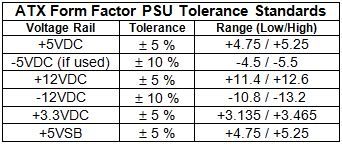I suspect the power supply.
How can I check this.
I have knowledge of electricity and electronics
Edited by teddles, 18 March 2011 - 05:48 AM.

Need help with your computer or device? Want to learn new tech skills? You're in the right place!
Geeks to Go is a friendly community of tech experts who can solve any problem you have. Just create a free account and post your question. Our volunteers will reply quickly and guide you through the steps. Don't let tech troubles stop you. Join Geeks to Go now and get the support you need!

Edited by teddles, 18 March 2011 - 05:48 AM.

To properly and conclusively test a power supply unit (PSU), it must be tested under various realistic "loads" then analyzed for excessive ripple and other anomalies. This is done by a qualified technician using an oscilloscope or power analyzer - sophisticated (and expensive) electronic test equipment requiring special training to operate, and a basic knowledge of electronics theory to understand the results. Therefore, conclusively testing a power supply is done in properly equipped electronic repair facilities.
Fortunately, there are other options that are almost as good. I keep a FrozenCPU Ultimate PSU Tester in my tool bag when I am "in the field" and don't have a good spare power supply to swap in. While not a certain test, they are better than nothing. The advantage of this model is that it has an LCD readout of the voltage. With an actual voltage readout, you have a better chance of detecting a "failing" PSU, or one barely within specified ATX Form Factor Standard tolerances. Lesser models use LEDs to indicate the voltage is just within some "range". These are less informative, considerably cheaper, but still useful for detecting PSUs that have already "failed". Newegg has several testers to choose from. All these testers contain a "dummy load" to fool the PSU into thinking it is connected to a motherboard, and therefore allows the PSU to power on, if able, without being attached to a motherboard - great for testing fans, but again, it is not a true load or suitable for conclusive testing.
Note the required voltage tolerance ranges:

NOTE: Disregard the -5VDC reading. It is no longer used.


Edited by Macboatmaster, 19 March 2011 - 08:28 PM.




There is no power supply inside the CPU. I suspect you mean the computer case. With that said, continue with Digerati tests.According to me, the main problem is the SMPS (Switch Mode Power Supply) box inside your CPU. Check whether the cables in-and-out the box are connected and plugged in properly or not.







On a more general basis, having eliminated the power button switch, I would strip, taking usual anti-static precautions, to motherboard, graphics -enabling onboard if the motherboard is so equipped, that will eliminate a fault on the graphics, keyboard and monitor of course. I would disconnect from the motherboard, all drives, sound card if separate, etc and ram.
0 members, 0 guests, 0 anonymous users







Community Forum Software by IP.Board
Licensed to: Geeks to Go, Inc.